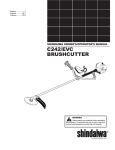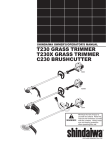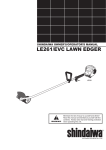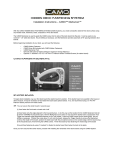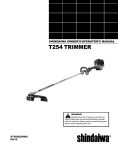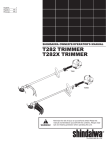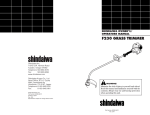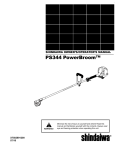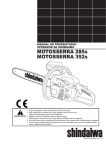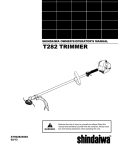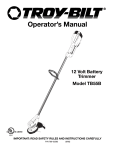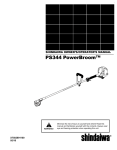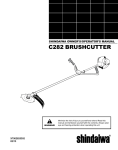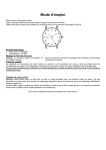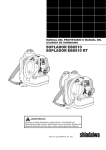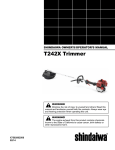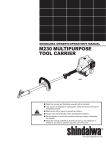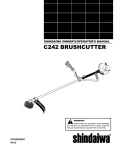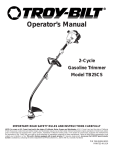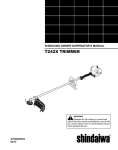Download Shindaiwa T282 User Manual
Transcript
English................1 Español.........SP_1 Françias........FR_1 SHINDAIWA OWNER’S/OPERATOR’S MANUAL T282 TRIMMER T282X TRIMMER T282 T282X WARNING! Minimize the risk of injury to yourself and others! Read this manual and familiarize yourself with the contents. Always wear eye and hearing protection when operating this unit. Part Number 89027 Rev. 11/08 Introduction The Shindaiwa 282 series is designed and built to deliver superior performance and reliability without compromise to quality, comfort, safety or durability. Shindaiwa engines represent the leading edge of high-performance engine technology, delivering exceptionally high power with remarkably low displacement and weight. As an owner/operator, you’ll soon discover for yourself why Shindaiwa is simply in a class by itself! Contents IMPORTANT! The information contained in these instructions describes units available at the time of publication. Shindaiwa Inc. reserves the right to make changes to products without prior notice, and without obligation to make alterations to units previously manufactured. PAGE Safety............................................................3 Product Description....................................5 Specifications...............................................5 Assembly......................................................6 Mixing fuel.................................................10 WARNING! The engine exhaust from this product contains chemicals known to the State of California to cause cancer, birth defects or other reproductive harm. PAGE Filling the fuel tank...................................10 Starting the Engine . ................................11 Stopping the Engine.................................12 Adjusting Engine Idle...............................12 Checking Unit Condition.........................12 PAGE Operation...................................................13 Maintenance..............................................15 Long Term Storage...................................18 Troubleshooting Guide............................19 Emission System Warranty Statement...22 IMPORTANT! The operational procedures described in this manual are intended to help you get the most from this unit as well as to protect you and others from harm. These procedures are guidelines for safe operation under most conditions, and are not intended to replace any safety rules and/or laws that may be in force in your area. If you have questions regarding your 282 Series, or if you do not understand something in this manual, contact your local authorized Shindaiwa dealer. You may also contact Shindaiwa Inc. at the address printed on the back of this Manual. Attention Statements Throughout this manual are special “attention statements”. DANGER! A statement preceded by the triangular attention symbol and the word “DANGER” contains information that should be acted upon to prevent serious injury or death. WARNING! CAUTION! A statement preceded by the triangular attention symbol and the word “WARNING” contains information that should be acted upon to prevent serious bodily injury. A statement preceded by the word “CAUTION” contains information that should be acted upon to prevent mechanical damage. IMPORTANT! A statement preceded by the word “NOTE” contains information that is handy to know and may make your job easier. A statement preceded by the word “IMPORTANT” is one that possesses special significance. NOTE: Warning and Operational Labels 50 FEET (15m) 2 Read and follow this operator's manual. Failure to do so could result in serious injury.. Beware of thrown or richocheted objects Always wear a harness when operating this unit with a blade. A harness is also recommended when using trimmer line. Wear eye and hearing protection at all times during operation of this unit. Wear head protection where there is a risk of falling objects. DO NOT use this unit with a blade! If unit is used as a brushcutter, beware of blade thrust. A jammed blade can cause the unit to jerk suddenly and may cause the operator to lose control of the unit. Make sure no one is within 15 M / 50 feet of an operating machine. 8” BARRIER DO NOT operate this unit with a blade unless the unit is equipped with a Shindawia-approved handlebar or barrier. Muffler, muffler cover and surrounding area will be high in temperature.There is risk of getting burned. Safety Work Safely WARNING! Trimmers and brushcutters operate at Never make unauthorized very high speeds and can do serious damattachment installations. age or injury if they are misused or abused. Never allow a person without training or Stay Alert instruction to operate this unit! You must be physically and mentally fit to operate this unit safely. WARNING! Never operate power equipment of any kind if you are tired or if you are under the influence of alcohol, drugs, medication or any other substance that could affect your ability or judgement. WARNING! Use Good Judgment ALWAYS inspect unit before each use. Replace any damaged parts. Inspect for broken, missing or improperly installed parts or attachments. ALWAYS use the proper cutting tool for the job. NEVER run the engine when transporting the unit. NEVER extend trimming line beyond the length specified for your unit. ALWAYS keep the handles clean. NEVER run the engine indoors! Make sure there is always good ventilation. Fumes from engine exhaust can cause serious injury or death. ALWAYS keep the unit as clean as practical. Keep it free of loose vegetation, mud, etc. ALWAYS stop the unit immediately if it suddenly begins to vibrate or shake. ALWAYS hold the unit firmly with both hands when cutting or trimming, and maintain control at all times. ALWAYS disconnect the spark plug wire before performing any maintenance work. ALWAYS, if a saw blade should bind fast in a cut, shut off the engine immediately. Push the branch or tree to ease the bind and free the blade. Safety Labels READ THE OPERATOR’ S M ANUAL WEAR HEARING AND ANSI Z8 7 .1 APPROVED EYE PROTECTION 50 FEET (15m) T282 KEEP BYSTANDERS AWAY AT LEAST 5 0 FEET (1 5 m) BEWARE OF THROWN OR RICOCHETED OBJECTS DO NOT OPERATE THIS M ACHINE WITH A BLADE Shindaiwa Inc. 19422-00028 T282X IMPORTANT! Safety and Operation Information Labels: Make sure all information labels are undamaged and readable. Immediately replace damaged or missing information labels. New labels are available from your local authorized Shindaiwa dealer. 3 Safety (continued) The Properly Equipped Operator Wear hearing protection devices and a broad-brimmed hat or helmet. A helmet is required when using a blade-equipped brushcutter to clear small trees. Always wear eye protection such as goggles or safety glasses to shield against thrown objects. Always wear a harness when operating the unit . It adds comfort and helps ensure safety by limiting movement fore and aft. When the harness is adjusted properly, the unit should balance with the cutting attachment parallel to the ground. Prolonged exposure to excessive noise is fatiguing and could lead to impaired hearing. Always operate with both hands firmly gripping the unit. Wear close-fitting clothing to protect legs and arms. Gloves offer added protection and are strongly recommended. Do not wear clothing or jewelry that could get caught in machinery or underbrush. Secure long hair so that it is above shoulder level. NEVER wear shorts! When operating with a blade, make sure the handle is positioned to provide you with maximum protection from contacting the blade. Always make sure the handlebar is installed in accordance with the manufacturers instructions. Always make sure the appropriate cutting attachment shield is correctly installed and in good condition. Do not operate the unit if the cutting attachment shield is missing, loose, or broken. Long-term exposure to vibration can damage your hands. Keep a proper footing and do not overreach. Maintain your balance at all times during operation. Keep away from the rotating trimmer line or blade at all times, and never lift a moving attachment above waist-high. Wear appropriate footwear (non-skid boots or shoes): do not wear opentoed shoes or sandals. Never work barefooted! Be Aware of the Working Environment Avoid long-term operation in very hot or very cold weather. Reduce the risk of bystanders being struck by flying debris. Make sure no one is within 15 meters (50 feet)— that’s about 16 paces of an operating attachment. Stop immediately if a child, pet, or person comes within a 15 meter (50 feet) radius. Outside this radius, there is still a risk of injury from thrown objects. Make sure bystanders or observers outside the 15 meter (50 feet) “danger zone” wear eye protection. 15 METERS (50 FEET) Be extremely careful of slippery terrain, especially during rainy weather. Always make sure the appropriate cutting attachment shield is correctly installed. Be constantly alert for objects and debris that could be thrown either from the rotating cutting attachment or bounced from a hard surface. If contact is made with a hard object, stop the engine and inspect the cutting attachment for damage. 4 Do not operate the unit if the cutting attachment shield is missing, loose, or broken. 15m (50ft) Beware of a coasting blade when brushcutting or edging. A coasting blade can injure while it continues to spin after the throttle trigger is released or after the engine is stopped. ALWAYS clear your work area of trash or hidden debris that could be thrown back at you or toward a bystander. When operating in rocky terrain or near electric wires or fences, use extreme caution to avoid contacting such items with the cutting attachment. Product Description T282 Ignition Switch Fuel Tank T282X Throttle Trigger Outer Tube Ignition Switch Strap Gearcase Cutting Attachment Shield Throttle Interlock Handle Grip Outer Tube Trimmer Head Throttle Trigger Barrier Bar Gearcase Fuel Tank Hanger Cutting Attachment Shield Trimmer Head Using the illustration as a guide, familiarize yourself with your machine and its various components. Understanding your machine helps ensure top performance, long service life and safer operation. IMPORTANT! WARNING! Do not make unauthorized modifications or alterations to any of these units or their components. The terms “left”, “left-hand”, and “LH”; “right”, “right-hand”, and “RH”; “front” and “rear” refer to directions as viewed by the operator during normal operation. Specifications Engine Name Engine Model Engine Type Dr y Weight (Without guard and strap) Dimensions Bore x Stroke Displacement Maximum Power Output Fuel/Oil Ratio Fuel Tank Capacity Carburetor Type Ignition Spark Plug Air Cleaner Type Starting Method Stopping Method Transmission Type EPA Emission Compliance Period* *Specifications are subject to change without notice. T282 T282X S282EV 2-cycle, catalyst 5.7 kg/12.6 lb. 6.0 kg/13.2 lb 1785 x 315 x 345 mm/70.3 x 12.4 x 13.6 in. 1790 x 375 x 330 mm/70.5 x 14.8 x 13 in. 1.38 x 1.18 in./ 35 x 30 mm 28.9 cc/1.7 cu. in. 1.4 HP (1.0 kW) @ 8000 (min-1) 50:1 with ISO-L-EGD or JASO FD class 2-cycle mixing oil* 750 ml/25.4 oz.. Walbro, WYK, diaphragm-type One-piece electronic, transistor-controlled BPMR6A Non-reversible foam filter element Recoil Slide switch Automatic, centrifugal clutch w/bevel gear Category A *The EPA emission compliance period referred to on the emission compliance label located on the engine, indicates the number of operating hours for which the engine has been shown to meet Federal emission requirements. Category C = 50 hours (Moderate), B = 125 hours (Intermediate) and A = 300 hours (Extended) 5 Assembly This unit comes fully assembled with the exception of the cutting attachment shield and cutting attachment. ■■Kit containing cutting attachment Prior to Assembly Before assembling, make sure you have all the components required for a complete unit and inspect unit and components for any damage. ■■Engine and shaft assembly ■■Cutting attachment shield ■■Cutting attachment shield, mounting bracket and hardware, this owner’s/operator’s manual and tool kit for routine maintenance. Tool kits vary by model and may include a spark plug/screwdriver combination wrench, and a scraper. Handle and barrier bar X unit The handle is attached at the factory and positioned vertically. Handle 1. Loosen socket headed capscrew at the base of handle and rotate the handle 90 degrees. NOTE: Handle Outer Tube Keep handle forward of handle positioning label! 2. Position the handle forward of the Handle Positioning Label at the best position for operator comfort (usually about 254 mm (10 inches) ahead of throttle housing). 3. Tighten the socket headed capscrew securely. 6 Hanger Throttle Assembly Barrier Bar Handle Positioning Label Assembly (continued) Cutting Attachment Shield 1. Insert the cutting attachment shield between the outer tube and the cutting attachment mounting plate. NOTE: It may be necessary to loosen the retaining nut and clamp screw to adjust cutting attachment shield mounting plate. 2. Fit the two shims and the bracket over the outer tube and loosely install the four socket-head screws. 3. Tighten the four socket-head cap screws to secure the cutting attachment shield. T282 Socket-Head Cap Screws Bracket Cutting Attachment Shield Shim Clamp Screw Shim CAUTION! Make sure the clamp screw and retaining nut are securely tightened before tightening the four socket-head cap screws. Outer Tube Drain Screw Line Cutter Mounting Plate Retaining Nut 4. Attach the subshield to the cutting attachment shield by snapping the hooks into the hook receivers.. CAUTION! Make sure the subshield is completely hooked at the hook receiver. WARNING! NEVER operate the unit without the cutting attachment shield installed and tightly secured! T282X Socket-Head Cap Screws Bracket Outer Tube Shim Clamp Screw Shim Mounting Plate Drain Screw Retaining Nut Cutting Attachment Shield w/subshield Line Cutter 7 Assembly (continued) Adjust Throttle Lever Free Play The throttle lever free play should be approximately 4-6 mm. Make sure that the throttle lever operates smoothly without binding. If it becomes necessary to adjust the lever free play, follow the procedures and illustrations that follow. 1. Loosen the air cleaner cover knob and remove the air cleaner cover. 2. Loosen the lock nut on the cable adjuster. 3. Turn the cable adjuster in or out as required to obtain proper free play. 4. Tighten the locknut. 5. Reinstall the air cleaner cover. 4-6 mm Throttle Free Play Throttle Lever Free Play Cable Adjuster Remove air cleaner cover Lock Nut Adjust as required to obtail 4-6 mm free play Install trimmer head T282 Retaining Plug To install a trimmer head onto a T282X, first remove the shaft bolt, bolt guard (see the next page). Holder Output shaft 1. Turn the trimmer over so that the gear case output shaft faces UP. 2. Remove and discard the black plastic protective cap from the output shaft. 3. Rotate the holder until the hole in the holder aligns with the notch on the gear case. Use the long end of the hex wrench to lock the holder and output shaft. 4. While holding the hex wrench, thread the trimmer head onto the output shaft, turning counter-clockwise. Using hand pressure only, tighten the trimmer head firmly on the output shaft. 8 Hex Wrench IMPORTANT! The trimmer head has a left-hand thread. For removal turn the trimmer head clockwise. 5. Remove the hex wrench. 6. Adjust the trimmer line length to reach no further than the line cutter on the cutting attachment shield. Trim to the correct length if necessary. The unit should now be completely assembled and ready for use with a trimmer head. WARNING! A standard grass trimmer with a loop handle should NEVER be operated with blade-type attachments. For blade use the trimmer must be fitted with a bicycle-type handlebar or a barrier bar that is located in front of the operator to reduce the risk of the operator from coming in contact with the cutting attachment (per ANSI B175.3). When using a blade, the unit must also be equipped with a harness or strap. Assembly (continued) Installing Brushcutter Blade T282X 1. Turn the unit upside down so the gear case output shaft is facing UP and remove the shaft bolt, bolt guard and holder B from the gear case shaft. 2. Align the hole in blade holder A with the matching hole in the gear case flange and then temporarily lock the output shaft by inserting a hex wrench through both holes. 3. Fit the blade over the flange on holder A. 4. Install blade holder B on the output shaft. Shaft Bolt Bolt Guard Holder B Gear Shaft Holder A CAUTION! Install the blade so its printed surface is visible to the operator when the brushcutter is in the normal operating position. WARNING! Temporarily lock the output shaft by inserting a hex wrench through both holes The blade must fit flat against the holder flange. The blade mounting hole must be centered over the raised boss on blade Holder A. WARNING! Blade Output Shaft Holder B must fit flush against the blade and the splines engaged to the output shaft. 5. Install the bolt guard and then the blade retaining bolt. Using the combination spark plug wrench/screwdriver, tighten the bolt firmly in a counter-clockwise direction. 6. Remove the hex wrench. Blade Holder B Hex Wrench IMPORTANT! Discard blades that are bent, warped, cracked, broken or damaged in any way. Use a sharp blade. A dull blade is more likely to snag and thrust. WARNING! Do not attach any blade to a unit without proper installation of all required parts. Failure to use the proper parts can cause the blade to fly off and seriously injure the operator and/or bystanders. Tighten the assembly (blade not shown for clarity) The unit should now be completely assembled and ready for use with a blade. 9 Mixing fuel CAUTION! ■■Never use any type of gasoline containing more than 10% alcohol by volume! Some types of gasoline contain alcohol as an oxygenate. Oxygenated gasoline may cause increased operating temperatures. Under certain conditions, alcoholbased gasoline may also reduce the lubricating qualities of some 2-cycle mixing oils. ■■Generic oils and some outboard oils may not be intended for use in high-performance 2-cycle engines, and should never be used in your Shindaiwa engine. CAUTION! This engine is designed to operate on a 50:1 mixture consisting of unleaded gasoline and ISO-L-EGD or JASO FD class 2-cycle mixing oil only. Use of non-approved mixing oils can lead to excessive carbon deposits. ■■Use only fresh, clean unleaded gasoline with a pump octane of 87 or higher. ■■Mix all fuel with a 2-cycle air-cooled mixing oil that meets or exceeds ISO-LEGD and/or JASO FD classified oils at 50:1 gasoline/oil ratio. CAUTION! Mix and pour fuel outdoors where there are no sparks and flames. Examples of 50:1 mixing quantities Gasoline liters 2.5 5 10 20 - 1 1 1 1 2-cycle mixing oil milliliters 50 100 200 400 ml ml ml ml IMPORTANT! Mix only enough fuel for your immediate needs! If fuel must be stored longer than 30 oil with fuel stabilizer is not days and used, it should first be treated with a fuel stabilizer such as STA-BIL™. Oil is a registered JASO FD classi-fied oil and also meets or exceeds ISO-L-EGD performance requirements. Shindaiwa One is recommended for use in all Shindaiwa low emissions engines. Shindaiwa One also includes a fuel stabilizer. Filling the fuel tank WARNING! Minimize the Risk of Fire ■■NEVER smoke or light fires near the engine. ■■ALWAYS stop the engine and allow it to cool before refueling. ■■ALWAYS Wipe all spilled fuel and move at least 3 meters (10 feet) from the fueling point and source before starting. ■■NEVER place flammable material close to the engine muffler. ■■NEVER operate the engine without the muffler and spark arrester screen in place and in good working condition. 10 ■■FUEL IS HIGHLY FLAMMABLE. ■■ALWAYS store gasoline in a con- tainer approved for flammable liquids. ■■ALWAYS inspect the unit for fuel leaks before each use. During each refill, check that no fuel leaks from around the fuel cap and/or fuel tank. If fuel leaks are evident, stop using the unit immediately. Fuel leaks must be repaired before using the unit. ■■ALWAYS move the unit at least 3 meters (10 feet) away from a fuel storage area or other readily flammable materials before starting the engine. 1. Place the unit on a flat, level surface. 2. Clear any dirt or other debris from around the fuel filler cap. CAUTION! Slowly remove the fuel cap only after stopping the engine 3. Remove the fuel cap, and fill the tank with clean, fresh fuel. 4. Reinstall the fuel filler cap and tighten firmly. 5. Wipe away any spilled fuel before starting engine. Starting the Engine IMPORTANT! Engine ignition is controlled by a two position switch mounted on the throttle housing labeled, “I” for ON or START and “O” for OFF or STOP. WARNING! WARNING! Never start the engine from the operating position. Keep all parts of your body away from the rotating cutting attachment and hot surfaces. 1. Slide the ignition switch to the “I” position. 2. Press the primer bulb until fuel can be seen flowing in the transparent return tube. 3. Set the choke lever to the CLOSED position if engine is cold. 4. While holding the outer tube firmly with left hand. Use your other hand to slowly pull the recoil starter handle until resistance is felt, then pull quickly to start the engine. Primer Bulb Slide ignition to ON Return Tube Press primer bulb... Closed Hold the unit firmly... IMPORTANT! The primer system only pushes fuel through the carburetor. Repeatedly pressing the primer bulb will not flood the engine with fuel. 5. When the engine starts, slowly move the choke lever to the “OPEN” position. If the engine stops after the initial start, close the choke and restart. Move the choke lever to the CLOSED position CAUTION! Do not pull the recoil starter to the end of the rope travel. Pulling the recoil starter to the end of the rope travel can damage the starter. ...and pull recoil starter handle upward Open IMPORTANT! If the engine fails to start after several attempts with the choke in the closed position, the engine may be flooded with fuel. If flooding is suspected, move the choke lever to the open position and repeatedly pull the recoil starter to remove excess fuel and start the engine. If the engine still fails to start, refer to the troubleshooting section of this manual. WARNING! The cutting attachment may rotate when the engine is started! When the engine starts ■■After the engine starts, allow the engine to warm up at idle for 2 or 3 minutes before operating the machine. Make sure the attachment is clear of obstructions! After engine starts, move choke to OPEN position ■■After the engine is warm, pick up the unit and clip on the strap or harness. See the section on "Using the Strap". ■■Advancing the throttle makes the cut- ting attachment rotate faster; releasing the throttle makes the attachment stop running. If the cutting attachment continues to rotate refer to “Engine Idle Adjustment” for engine idle adjustment procedures. Starting a warm engine Starting a warm engine involves all of the steps of starting a cold engine, EXCEPT: ■■Do not press the primer bulb. ■■The choke should be in the OPEN ( position. ) If the engine does not start, follow the cold engine starting procedure. 11 Starting the Engine (continued) Starting a flooded engine 1. Slide the ignition switch button to the STOP position. 2. Disconnect the spark plug wire, and remove the spark plug. 5. Hold the throttle control lever depressed and crank the engine several times to clear excess fuel from the combustion chamber. 3. If the spark plug electrodes and ceramic 6. Reinstall the spark plug and tighten it firmly. If a torque wrench is available, insulator are fouled or soaked with fuel, torque the spark plug to 17–19 N·m clean or replace the plug. For spark plug (150- 168 lb.-in.). specifications and gapping procedure, refer to the “Maintenance” section. 7. Repeat the warm engine starting procedure. 8. If the engine fails to start, consult the troubleshooting guide provided. CAUTION! Incorrect spark plug installation may cause serious engine damage! 4. Open the choke. Stopping the Engine Idle the engine briefly before stopping (about 2 minutes), then slide the ignition switch to the “O” (Engine OFF) position. OFF CAUTION! A coasting blade can cause injury while it continues to spin after the engine is stopped or throttle trigger is released. Maintain proper control until the blade has completely stopped rotating. IMPORTANT When the unit is turned off make sure the cutting attachment has stopped before the unit is set down. Slide ignition to OFF Adjusting Engine Idle The engine must return to idle speed whenever the throttle lever is released. Idle speed is adjustable, and must be set low enough to permit the engine clutch to disengage the cutting attachment. Idle Speed Adjustment WARNING! The cutting attachment must NEVER rotate at engine idle! If the idle speed cannot be adjusted by the procedure described here, return the trimmer to your Shindaiwa dealer for inspection. 1. Place the trimmer on the ground, then start the engine, and then allow it to idle 2-3 minutes until warm. 2. If the attachment rotates when the engine is at idle, reduce the idle speed by turning the idle adjustment screw counter-clockwise. 3. If a tachometer is available, the engine idle speed should be final adjusted to 2,750 (±250) min-1 (rpm). 4. Carburetor fuel mixture adjustments are preset at factory and cannot be serviced in the field. Idle Adjusting Screw Adjusting engine idle Checking Unit Condition NEVER operate the unit with the cutting attachment shield or other protective devices removed! Use only authorized Shindaiwa parts and accessories with your Shindaiwa trimmer. Do not make modifications to this unit without written approval from Shindaiwa, Inc. ALWAYS make sure the cutting attachment is properly installed and firmly tightened before operation. NEVER use a cracked or warped cutting attachment: replace it with a ser viceable one. 12 The cutting attachment may be spinning during carburetor adjustments. Wear your protective equipment and obser ve all safety instructions. ALWAYS make sure the cutting attachment fits properly into the appropriate attachment holder. If a properly installed attachment vibrates, replace the attachment with new one and re-check. ALWAYS stop the engine immediately and check for damage if you strike a foreign object or if the unit becomes tangled. Do not operate with broken or damaged equipment. WARNING! A cutting attachment shield or other protective device is no guarantee of protection against ricochet. YOU MUST ALWAYS GUARD AGAINST FLYING DEBRIS! NEVER allow the engine to run at high RPM without a load. Doing so could damage the engine. NEVER operate a unit with worn or damaged fasteners or attachment holders. When transporting, make sure the engine is not running and the blade is covered with the blade cover. Operation Shoulder Strap T282X IMPORTANT WARNING! Always wear a shoulder strap when operating this unit with a blade. Wearing a shoulder strap with a grass trimmer can increase operator comfort during extended periods of operation. Strap Adjust the shoulder strap so the shoulder pad rests comfortably on the off-side shoulder and the cutting path of the cutting attachment is parallel to the ground. Make sure all hooks and adjustment devices are secure. NOTE: Using a shoulder strap when operating this unit with a blade allows you to maintain proper control of the unit and reduces fatigue during extended operation. 1. Hook the strap hook to the hanger on the outer tube. 2. Wear the shoulder strap so that the hook stays at your right hand side. 3. Adjust the length of the shoulder strap so that you can hold and operate the machine comfortably. Cutting grass with a trimmer head Your Shindaiwa unit may be equipped with Engine Operating Speeds one of several Shindaiwa trimmer head mod- Operate at full throttle while cutting grass. els, each with features for specific applicaTrimming and Mowing Grass tions and/or operational requirements. Hold the grass trimmer so the trimmer NOTE: head is angled slightly into the area to be For proper operation, always refer to the cut. To ensure maximum trimmer-line serinstructions accompanying the trimmer vice life, cut only with the tip of the trimhead being used. mer line. Cut grass by swinging the unit’s trimmer head from left to right. Keep the Trimmer head styles: trimmer head horizontal. Semi-automatic. Trimmer line is indexed when the operator taps the trimmer head on the ground during operation. Manual. The operator indexes line manually with the grass trimmer stopped. Fixed. The operator must stop the unit and add new lengths of trimmer line manually. Flail. This device, designed for clearing weeds and light brush, features three nylon blades attached to the head by pivots. CAUTION! Use only flexible, nonmetallic line recommended by the manufacturer. Never use, for example, wire or wire-rope, which can break off and become a dangerous projectile. CAUTION! ■■ Do not push the rotating line into trees, wire fences or any material that could tangle or break line ends. ■■ Operation of trimmer without a cutting attachment shield and using excessive line length can lead to premature clutch failure. ■■Operation at low rpm can lead to premature clutch failure. WARNING! Remove all objects such as rocks, broken glass, nails, wire, or string, which can be thrown or become entangled in the cutting attachment. NOTE: Additional hardware may be required to mount the Fixed Line or the Flail type trimmer heads. Edging Tilt the handle about 100° to the left (from horizontal) and move forward, holding the trimmer or brushcutter vertically as shown. Tilt the handle about 100° to the left 13 Operation (continued) Using a Blade T282X WARNING! ■■ Whenever you strike a hard object with a blade, always stop the brushcutter and carefully inspect the blade for damage. ■■Before working with a blade-equipped NEVER OPERATE THE BRUSHCUTTER WITH A DAMAGED BLADE! unit, always inspect and clean the area of objects that could interfere ■■A blade-equipped unit must be with or damage the blade. equipped with a bicycle-type handlebar or barrier bar as well as a har■■Never use a blade near sidewalks, ness or shoulder strap. fence posts, buildings or other objects that could cause injury or damage. ■■Always make sure the cutting attach■■Never use a blade for purposes other ment shield is properly installed before operating this unit. than those for which it was designed. Blade Thrust “Blade thrust” is a sudden sideways or backward motion of the brushcutter. Such motion may occur when the blade jams or catches on an object such as a sapling tree or tree stump. BE CONSTANTLY ALERT FOR BLADE THRUST AND GUARD AGAINST ITS EFFECTS! WARNING! Blade thrust can occur without warning if the blade snags, stalls or binds WARNING! Blade thrust is more likely to occur in areas where it is difficult to see the material being cut. Brushcutter Handlebar A brushcutter handlebar or barrier bar helps prevent the operator from moving forward, or the unit moving rearward, thus preventing inadvertent bodily contact with the blade. ALWAYS KEEP THE HANDLEBAR OR BARRIER BAR SECURELY IN PLACE ON THE UNIT! Brushcutter harness A harness provides additional protection against blade thrust. In addition, a harness gives significant support and comfort to help ensure safe and efficient operation. When operating a unit with a blade, make sure both the handle and harness are adjusted to the size of the operator using the unit. Engine Operating Speeds Operate the unit at full throttle while cutting. Best fuel efficiency is obtained by releasing the throttle when swinging back after a cut. ■■To prevent possible engine damage, do not allow the brushcutter to run at high speeds without a load. ■■ Avoid operating the engine at low speeds. Doing so can lead to rapid clutch wear. In addition, slow-speed operation tends to cause grass and debris to wrap around the cutting head. Using a Blade T282X Ten O'clock WARNING! DO N T O T Blade Rotation CU The blade rotates counter-clockwise. For best performance and to minimize being stuck by debris, move the blade from right to left while advancing on your work. Position the blade so cuts are made between the blade’s 8 o’clock and 10 o’clock positions (as viewed from above). DO NOT cut between the 10 o’clock and 5 o’clock positions. OK To Cut When cutting wood with a blade, feed the blade slowly—never strike or “slam” a spinning blade against the wood. WARNING! Eight O'clock Five O'clock DO NOT use 2-tooth or nonShindaiwa approved 4-tooth cutting blades with Shindaiwa trimmers and brushcutters. Vertical Cuts Hold the brushcutter with the blade at a 90° angle to the ground so the blade’s bottom edge rotates toward the operator. Move the blade from top to bottom through the cut, and cut only with the bottom edge of the blade. 14 Cut on the left side of the blade. KEEP YOUR BODY OUTSIDE THE PATH OF BLADE ROTATION. WARNING! When making vertical cuts, never allow the blade to exceed waist height. Maintenance General maintenance IMPORTANT! MAINTENANCE, REPLACEMENT OR REPAIR OF EMISSION CONTROL DEVICES AND SYSTEMS MAY BE PERFORMED BY ANY REPAIR ESTABLISHMENT OR INDIVIDUAL; HOWEVER, WARRANTY REPAIRS MUST BE PERFORMED BY A DEALER OR SERVICE CENTER AUTHORIZED BY SHINDAIWA INC. THE USE OF PARTS THAT ARE NOT EQUIVALENT IN PERFORMANCE AND DURABILITY TO AUTHORIZED PARTS MAY IMPAIR THE EFFECTIVENESS OF THE EMISSION CONTROL SYSTEM AND MAY HAVE A BEARING ON THE OUTCOME OF A WARRANTY CLAIM. WARNING! Non-standard accessories, cutting attachment, or replacement parts may not operate properly with your unit and may cause damage and lead to personal injury. WARNING! Before performing any maintenance, repair, or cleaning work on the unit, make sure the engine and cutting attachment are completely stopped. Disconnect the spark plug wire before performing service or maintenance. Muffler This unit must never be operated with a faulty or missing spark arrester or muffler. Make sure the muffler is well secured and in good condition. A worn or damaged muffler is a fire hazard and may also cause hearing loss. Spark Plug Keep the spark plug and wire connections tight and clean. Fasteners Make sure nuts, bolts, and screws (except carburetor adjusting screws) are tight. NOTE: Using non-standard replacement parts could invalidate your Shindaiwa warranty. Daily maintenance Prior to each work day, perform the following: ■■Remove all dirt and debris from the engine, check the cooling fins and air cleaner for clogging, and clean as necessary. ■■Clean any debris or dirt from the cutting attachment. ■■Check the entire unit for leaking fuel or grease. ■■Check for loose or missing screws or components. Make sure the cutter attachment is securely fastened. ■■Make sure nuts, bolts, and screws Blades Keep blades sharp and check blade condition frequently. If a blade’s performance changes suddenly, stop the engine and check the blade for cracks or other damage. Replace a damaged blade IMMEDIATELY! WARNING! ■■Never repair a damaged blade by welding, straightening, or by modifying its shape. An altered blade may break during operation, resulting in serious personal injury. ■■DO NOT use 2-tooth or NONShindaiwa approved 4-tooth cutting blades on Shindaiwa trimmers or brushcutters. ■■Blades are not interchangeable between Shindaiwa edgers and trimmer/brushcutter models. Operating any unit with a blade or attachment not approved for that unit can be hazardous and may cause serious injury. ■■ Carefully remove any accumulations of dirt or debris from the muffler and fuel tank. Check cooling air intake area at base of crankcase. Remove all debris. Dirt build-up in these areas can lead to engine overheating, fire, or premature wear. (except carburetor idle speed adjusting screws) are tight. 10-hour maintenance Perform more frequently in dusty or dirty conditions. Remove and clean or replace the element Remove the air cleaner filter. Clean or replace as necessary. To clean filter wash it thoroughly in soap and water. Let it dry before reinstalling the filter. CAUTION! Do not operate the unit if the air cleaner or filter is damaged, or if the filter is wet or water soaked. Unscrew Fastener 15 Maintenance (continued) 10/15 hour maintenance Ever y 10 to 15 hours of operation: Remove and clean the spark plug. Adjust the spark plug electrode gap to 0.024 - 0.028 inch (0.6 - 0.7 mm). If the spark plug must be replaced, use only an NGK BPMR6A or equivalent resistor type spark plug of the correct heat range (0.6–0.7 mm) 0.024–0.028 inch CAUTION! Before removing the spark plug, clean the area around the plug to prevent dirt and debris from getting into the engine’s internal parts. . Clean the spark plug and check the gap at the electrode. NOTE The NGK BPMR6A also meets the requirements for electro magnetic compliance (EMC). spark plug ga 50 hour maintenance Ever y 50 hours of operation, lubricate gearcase (more often in dusty or dirty conditions): Lubricate gearcase Without cutting attachment installed on gear case: ■■Remove and clean the cylinder cover New grease and clean grass and dirt from the cylinder fins. ■■Remove the cutting attachment, cut- ting attachment holder and gear shaft collar. Remove the filler plug from the side of the gear case and press new grease into the gear case until old grease is pushed out. Use only lithiumbase grease such as Shindaiwa Gear Case Lubricant or equivalent. Old grease Gear shaft collar Without cutting attachment installed on gearcase ■■Remove mainshaft and lubricate both ends of the splines. With cutting attachment installed on gear case: Drain Screw Lubricate gearcase ■■Remove and clean the cylinder cover and clean grass and dirt from the cylinder fins. ■■Remove the filler plug and drain screw from the side of the gear case and press new grease into the gear case until old grease is pushed out. Use only lithium-base grease such as Shindaiwa Gear Case Lubricant or equivalent. ■■Remove mainshaft and lubricate both ends of the splines. 16 New grease Old grease Cutting attachment not shown With cutting attachment installed on gearcase Maintenance (continued) 50 hour maintenance Remove and replace the fuel filter element. Before reinstalling the new filter element, inspect the condition of all the fuel system components (fuel pick-up line, fuel return line, tank vent line, tank vent, fuel cap and fuel tank). If damage, splitting or deterioration is noted, the unit should be removed from service until it can be inspected or repaired by a Shindaiwatrained service technician. Hooked wire CAUTION! Make sure you do not pierce the fuel line with the end of the hooked wire. The line is delicate and can be damaged easily. Fuel filter maintenance Fuel filter element 135 hour maintenance Engine Cover Engine Cover Screws Muffler Cover Muffler Cover Screw Muffler Muffler Screws Gasket Screws Spark Arrester Outlet Spark Arrester Screen Cover Muffler Gasket Muffler and spark arrester maintenance Ever y 135 hours of operation, remove and clean the muffler. WARNING! Never operate the unit with a damage or missing muffler or spark arrester! Operating with a missing or damaged spark arrester is a fire hazard and could also damage your hearing. If the engine becomes sluggish and low on power, check and clean the spark arrester screen. 1. Remove the spark plug boot. 2. With a 4mm hex wrench remove the 1 muffler cover and 3 engine cover screws and the engine cover. The muffler cover is attached to the engine cover at the top and front by tabs. To remove push inward at arrow area while pulling outward. See insert image. 3. With a Phillips type screwdriver remove the 5 screws holding the spark arrester screen and cover to the muffler. 4. Remove the screen and clean it with a stiff bristle brush. 5. Remove the 3 muffler bolts and the muffler. 6. Inspect the cylinder exhaust port for any carbon buildup. 7. Gently tap the muffler on a wood surface to dislodge any loose carbon. 8. Reassemble the spark arrester, muffler and engine cover in the reverse order of disassembly. IMPORTANT! If you note excessive carbon buildup, consult with an authorized Shindaiwa servicing dealer. 17 Maintenance (continued) Blade Sharpening When the cutting edges of the blade become dull, they can be resharpened with a few strokes of a file. Multiple-tooth Circular Blade In order to keep the blade in balance, all cutting edges must be sharpened equally. Round File Shindaiwa Tornado™ Blade To sharpen the cutters on a Shindaiwa Tornado™ Blade, use a 7/32-inch round file. File the leading edge of each tooth to a razor edge. The top plate of each tooth should angle back 30°. 27041 30° 300 Use a round file to maintain a radius of 0.04 to 0.06” (1 to 1.5 mm) at the base of each tooth. Cutting edges must be offset equally on each side. Round File WARNING! Sharpen only the cutting teeth of a blade. DO NOT alter the contour of the blade in any way. WARNING! Wear protective gloves when handling or performing maintenance on the blade. Long Term Storage Whenever the unit will not be used for 30 days or longer, use the following procedures to prepare it for storage: ■■Clean external parts thoroughly. ■■Drain all the fuel from the carburetor and the fuel tank. IMPORTANT! All stored fuels should be stabilized with a fuel stabilizer such as STA-BIL, if oil with fuel stabilizer is not used. CAUTION! Gasoline stored in the carburetor for extended periods can cause hard starting, and could also lead to increased service and maintenance costs. 18 ■■Remove remaining fuel from the fuel lines and carburetor with the fuel drained from the fuel tank. To do so: 1.Prime the primer bulb until no more fuel is passing through. 2.Start and run the engine until it stops running. 3.Repeat steps 1 and 2 until the engine will no longer start. ■■Remove the spark plug and pour about 1/4 ounce of 2-cycle mixing oil into the cylinder through the spark plug hole. Slowly pull the recoil starter 2 or 3 times so oil will evenly coat the interior of the engine. Reinstall the spark plug. ■■Before storing the unit, repair or replace any worn or damaged parts. ■■Remove the air cleaner element from the carburetor and clean it thoroughly with soap and water, let dry and reassemble the element. ■■Store the unit in a clean, dust-free area. Troubleshooting Guide ENGINE DOES NOT START What To Check Possible Cause Faulty recoil starter. Does the engine crank? NO Fluid in the crankcase. Remedy Consult with an authorized servicing dealer. Internal damage. YES Good compression? Loose spark plug. Tighten and re-test. Excess wear on cylinder, piston, rings. Consult with an authorized servicing dealer. NO Fuel incorrect, stale, or contaminated; mixture incorrect. Refill with fresh, clean unleaded gasoline with a pump octane of 87 or higher mixed with a 2-cycle mixing oil that meets or exceeds ISO-L-EGD and/or JASO FD classified oils at 50:1 gasoline/oil ratio. NO Check for clogged fuel filter and/ or vent. Replace fuel filter or vent as required. Restart. Primer pump functioning incorrectly. Consult with an authorized servicing dealer. The ignition switch is in “O” (OFF) position. Move switch to “I” (ON) position and restart. Shorted ignition ground. Consult with an authorized servicing dealer. NO YES Does the tank contain fresh fuel of the proper grade? YES Is fuel visible and moving in the return line when priming? YES Is there spark at the spark plug wire terminal? YES Check the spark plug. NO Faulty ignition unit. If the plug is wet, excess fuel may be in the cylinder. Crank the engine with the plug removed, reinstall the plug, and restart. The plug is fouled or improperly gapped. Clean and regap the plug to 0.6 mm - 0.7 mm. Restart. The plug is damaged internally or of the wrong size. Replace the spark plug. Check the “Specifications” section for the correct plug for your unit. Restart. 19 Troubleshooting Guide (continued) LOW POWER What To Check Is the engine overheating? Engine is rough at all speeds. May also have black smoke and/or unburned fuel at the exhaust. Possible Cause Operator is overworking the unit. Operate at slower rate. Carburetor mixture is too lean. Consult with an authorized servicing dealer. Improper fuel ratio. Refill with fresh, clean unleaded gasoline with a pump octane of 87 or higher mixed with a 2-cycle mixing oil that meets or exceeds ISO-L-EGD and/ or JASO FD classified oils at 50:1 gasoline/oil ratio. Fan, fan cover, cylinder fins dirty or damaged Clean, repair or replace as necessary. Carbon deposits on the piston or in the muffler. Consult with an authorized servicing dealer Clogged air cleaner element. Clean or replace the air filter Loose or damaged spark plug. Tighten or replace the spark plug. Restart. Check the Specifications page in this manual for the correct spark plug for this unit. Air leakage or clogged fuel line. Repair or replace fuel filter and/or fuel line. Water in the fuel. Refill with fresh fuel/oil mixture. Piston seizure. Faulty carburetor and/or diaphragm Consult with an authorized servicing dealer. Overheating condition. Consult with an authorized servicing dealer. Improper fuel. Check fuel octane rating; check for presence of alcohol in the fuel. Refuel as necessary. Carbon deposits in the combustion chamber. Consult with an authorized servicing dealer. Engine is knocking. 20 Remedy Troubleshooting Guide (continued) ADDITIONAL PROBLEMS What To Check Possible Cause Clogged air filter. Poor acceleration. Engine stops abruptly. Engine difficult to shut off. Cutting attachment moves at engine idle. Attachment will not move. Clogged fuel filter. Engine will not idle down. Clean or replace the air filter. Replace the fuel filter. Lean fuel/air mixture. Consult with an authorized servicing dealer. Idle speed set too low. Adjust: 2,750 (±250) min-1. Switch turned off. Reset the switch and re-start. Fuel tank empty. Refuel. See Fuel section of manual. Clogged fuel filter. Replace fuel filter. Water in the fuel. Drain; replace with clean fuel. See Fuel section of manual. Shorted spark plug or loose terminal. Clean or replace spark plug. Check the Specifications page in this manual for the proper spark plug for your unit. Tighten the terminal. Ignition failure. Replace the ignition unit. Piston seizure. Consult with an authorized servicing dealer Ground (stop) wire is disconnected or switch is defective Test and replace as required. Overheating due to incorrect spark plug Idle engine until cool. Replace the spark plug. Check the Specifications page in this manual for the proper spark plug for your unit. Overheated engine. Idle engine until cool. Engine idle too high. Set idle: 2,750 (±250) min-1. Broken clutch spring or worn clutch spring boss. Replace spring/shoes as required. Loose attachment holder. Inspect and re-tighten holders securely. Shaft not installed in powerhead or gearcase. Inspect and reinstall as required. Broken shaft. Damaged gearcase. Excessive vibration. Remedy Consult with a authorized servicing dealer. Warped or damaged attachment. Inspect and replace attachment as required. Loose gearcase. Tighten gearcase securely. Bent main shaft/worn or damaged bushings. Inspect and replace as necessary. Engine idle is set too high. Set idle: 2,750 (±250) min-1. Engine has air leak. Consult with a authorized servicing dealer. 21 Emission System Warranty Statement Your Warranty Rights and Obligations Owners Warranty Responsibilities The California Air Resources Board, the U.S. Environmental Protection Agency and Shindaiwa Corporation are pleased to explain the exhaust and evaporative emission control system warranty on your new small off-road (non-road) engine. In California, new small off-road engines must be designed, built, and equipped to meet the State’s stringent anti-smog standards. In other states, new 1997 and later non-road engines must meet the Federal EPA’s stringent anti-smog standards. Shindaiwa Corporation must warrant the emission control system on your small off-road engine for the periods of time listed below, provided there has been no abuse, neglect, or improper maintenance of your small off-road engine. Your engine exhaust and evaporative emission control system includes parts such as the carburetor, fuel tank, the ignition system and, if equipped, the catalytic converter. These components are specifically listed below. Where a warrantable condition exists, Shindaiwa Corporation will repair your small off-road engine at no cost to you including diagnosis, parts, and labor. As the small off-road engine owner, you are responsible for the performance of the required maintenance listed in this owners manual. Shindaiwa Corporation recommends that you retain all receipts covering maintenance on your small off-road engine, but Shindaiwa Corporation cannot deny warranty solely for the lack of receipts or for your failure to ensure the performance of all scheduled maintenance. As the small off-road engine owner, you should be aware, however, that Shindaiwa Corporation may deny you warranty coverage if your small off-road engine or a part has failed due to abuse, neglect, improper maintenance, or unapproved modifications. You are responsible for presenting your small off-road engine to an authorized Shindaiwa Corporation Dealer as soon as a problem exists. The warranty repairs should be completed in a reasonable amount of time, not to exceed 30 days. If you have any questions regarding your warranty rights and responsibilities, you should contact a Shindaiwa Corporation customer service representative or your local Shindaiwa Dealer. Consequential Damages Manufacturer’s Warranty Coverage When sold within the U.S., this engine’s emission control system is warranted for a period of two (2) years from the date this product is first delivered to the original retail purchaser. During the warranty period, Shindaiwa Corporation will, at their option, repair or replace any defective emission-related component on this engine. During the original Warranty Period, these Warranty Rights are automatically transferable to subsequent owners of this product. What is Covered by this Warranty 1. Carburetor Internal Components ■■ Throttle Valve, Needle, Jet, Metering Diaphragm 2. Fuel Tank 3. Ignition System Components ■■ Ignition Coil ■■ Flywheel Rotor 4. Catalytic Converter (if originally equipped) The emission control system for your particular Shindaiwa Corporation engine may also include certain related hoses and connectors. 22 In the event that other component parts of this product are damaged by the failure of a warranted part, Shindaiwa Corporation will repair or replace such component parts at no charge to you. What is Not Covered ■■ Failures caused by abuse, neglect, or improper nance procedures. mainte- ■■ Failures caused by the use of modified or non-approved parts or attachments. This Warranty is Administered by: Shindaiwa Corporation 11975 SW Herman Road Tualatin, OR 97062 (503) 692-3070 NOTES NOTES Shindaiwa Inc. 11975 SW Herman Rd. Tualatin, Oregon 97062 U.S.A. Telephone: 503 692-3070 Fax: 503 692-6696 www.shindaiwa.com Shindaiwa Corporation. 6-2-11, Ozuka-Nishi, Asaminami-Ku, Hiroshima 731-3167, Japan Telephone: 81-82-849-2220 Fax: 81-82-849-2481 © 2008 Shindaiwa Inc. Part Number 89027 Rev. 11/2008 Shindaiwa is a registered trademark of Shindaiwa Inc. Specifications subject to change without notice.
























